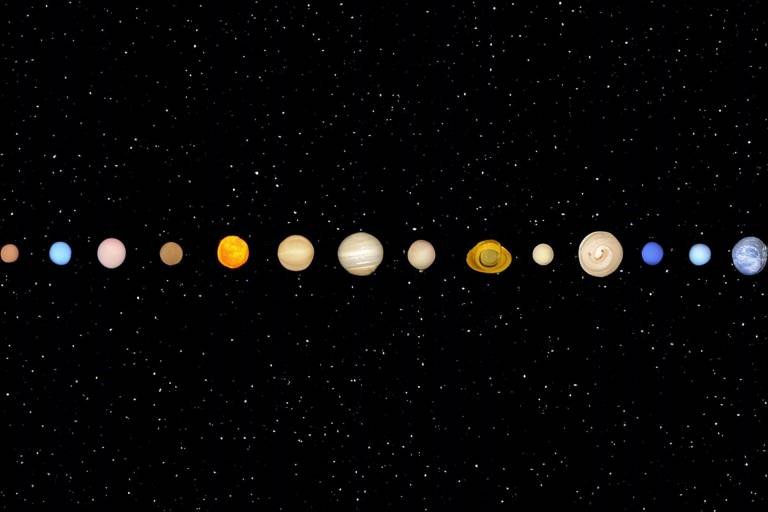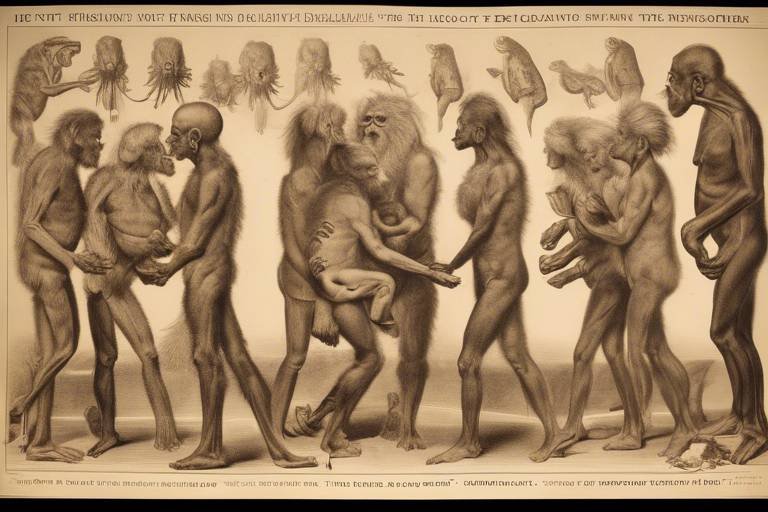Philosophy and Science - An Examination of Climate Models
Climate change is one of the most pressing issues of our time, and understanding it requires a deep dive into the intricate world of climate models. These models are not just mere computer simulations; they are sophisticated tools that blend science and philosophy, offering us insights into the future of our planet. But what exactly are climate models, and why do they matter? In this article, we'll explore the intersection of philosophy and science, particularly how climate models operate, their reliability, and the philosophical questions they raise about knowledge, uncertainty, and our understanding of climate change.
At their core, climate models are designed to simulate the Earth's climate system. They use mathematical equations to represent the physical processes that govern climate, such as the interaction between the atmosphere, oceans, land surface, and ice. These models can make predictions about future climate scenarios based on different greenhouse gas emission trajectories and other variables. However, the reliability of these predictions is often questioned. This is where the philosophical implications come into play. How do we know that our models accurately reflect reality? What assumptions are we making, and how do they affect our predictions? These questions not only challenge scientists but also engage philosophers who ponder the nature of knowledge and truth.
In the realm of climate science, uncertainty is a constant companion. No model can predict the future with absolute certainty, and this inherent uncertainty raises significant philosophical implications. For example, how do we balance the need for decisive action against climate change with the knowledge that our predictions come with a degree of uncertainty? This dilemma often influences public perception and decision-making. When faced with uncertain outcomes, individuals and policymakers may hesitate to act, fearing the consequences of being wrong. Thus, understanding how uncertainty operates within climate models is crucial for fostering informed discussions about climate action.
Now, let’s take a closer look at some of the philosophical dimensions of climate modeling. One critical aspect is epistemology, the study of knowledge. In climate science, epistemology examines how knowledge is constructed and validated within the context of climate models. Scientists must grapple with the challenges of validating model predictions against real-world data. This process involves rigorous testing and comparison, but it also raises philosophical questions about the limitations of our knowledge. How do we know when a model is 'good enough'? And what do we do when models disagree?
Climate models serve as essential tools for understanding climate dynamics. They are pivotal in predicting future climate scenarios and informing policy decisions. The methodology behind these models often involves complex algorithms that take into account various factors, including solar radiation, atmospheric composition, and ocean currents. By simulating these interactions, scientists can project potential climate outcomes based on different scenarios. However, the significance of these models extends beyond mere predictions; they play a crucial role in shaping our understanding of climate change and guiding policy responses.
Uncertainty in climate modeling is not just a technical issue; it is a profound philosophical concern. The implications of uncertainty reach into the heart of how we perceive knowledge and action in the face of climate change. For instance, when scientists present their findings with varying degrees of certainty, it can lead to public confusion and skepticism. This ambiguity can undermine trust in scientific authority and complicate efforts to mobilize action against climate change. Therefore, it is essential to communicate these uncertainties effectively, ensuring that policymakers and the public understand both the risks and the limitations of climate predictions.
Epistemology, as it relates to climate science, challenges us to consider the nature of knowledge itself. In the context of climate models, knowledge is constructed through a combination of empirical data, theoretical frameworks, and computational simulations. However, validating this knowledge is fraught with difficulties. Scientists must constantly question the assumptions underlying their models and the extent to which these assumptions reflect reality. This ongoing process of validation and verification is not merely a technical endeavor; it is a philosophical journey that challenges our understanding of what it means to know something in an ever-changing climate landscape.
Validating and verifying climate models is essential for their credibility. Scientists employ various methods to assess the accuracy of their models, including:
- Comparing model outputs with historical climate data
- Conducting sensitivity analyses to understand how changes in input variables affect outcomes
- Using ensemble modeling techniques to capture a range of possible futures
These methods help establish a level of confidence in model predictions, but they also raise philosophical questions about the limitations of our understanding. For instance, can we ever fully capture the complexity of the climate system through models? And what happens when models diverge significantly in their predictions?
Every climate model is built on a set of assumptions, and these assumptions can significantly impact the outcomes. Philosophically, questioning these assumptions is crucial. Are they valid? Do they reflect the complexities of the climate system? Understanding the implications of these assumptions can help us better interpret model results and make informed decisions based on them. For example, if a model assumes a linear relationship between carbon emissions and temperature rise, it may not account for potential feedback loops that could exacerbate warming.
The ethical implications of climate predictions are profound and multifaceted. Scientists have a responsibility to communicate risks and uncertainties to policymakers and the public transparently. This responsibility extends beyond mere data presentation; it involves framing the narrative in a way that fosters understanding and encourages action. The stakes are high, and the consequences of inaction can be dire. Thus, ethical considerations must guide how scientists engage with society, ensuring that their work contributes to informed decision-making.
An interdisciplinary approach enhances our understanding of climate models. By integrating philosophy, sociology, and environmental science, we can develop more robust climate predictions and policies. This collaboration allows for a more comprehensive view of climate change, considering not only the scientific data but also the societal implications and ethical responsibilities associated with climate action.
Social constructs significantly affect the interpretation of climate data. Societal values and beliefs shape how climate models are developed, accepted, and acted upon. Understanding these social dynamics is crucial for effective communication and policy-making. For instance, public perception of climate change can be influenced by cultural narratives, political ideologies, and media representations. Recognizing these influences can help scientists and policymakers tailor their messages to resonate with diverse audiences.
The future of climate modeling lies in innovation and adaptation. Emerging technologies, such as machine learning and big data analytics, have the potential to enhance the accuracy and reliability of climate predictions. By leveraging these tools, scientists can analyze vast amounts of data and identify patterns that may not be apparent through traditional methods. As we move forward, it is essential to remain open to new methodologies and perspectives, ensuring that our understanding of climate change continues to evolve.
- What are climate models? Climate models are mathematical representations of the climate system that simulate interactions between various components of the Earth’s climate.
- How reliable are climate models? While climate models provide valuable insights, they come with inherent uncertainties that can affect their predictions.
- Why is uncertainty important in climate science? Understanding uncertainty helps policymakers and the public make informed decisions about climate action.
- What role does philosophy play in climate modeling? Philosophy helps us question the assumptions and implications of climate models, guiding our understanding of knowledge and ethics in climate science.

The Role of Climate Models in Science
Climate models are not just fancy computer programs; they are the **backbone of our understanding** of climate dynamics. Imagine trying to predict the weather without a forecast—it's a bit like trying to navigate a ship through a storm without a compass! These models simulate the Earth's climate system, allowing scientists to explore how various factors—like greenhouse gas emissions, solar radiation, and volcanic activity—interact over time. By doing so, they help us predict future climate scenarios, which is crucial for making informed policy decisions.
At their core, climate models are built on a combination of **mathematical equations** and empirical data. They take into account the physical laws that govern the atmosphere, oceans, and land surfaces. This intricate web of equations helps scientists understand how energy is transferred within the Earth’s system. For instance, when we talk about the greenhouse effect, climate models illustrate how gases like carbon dioxide trap heat in the atmosphere, leading to global warming. Without these models, our grasp of such complex interactions would be significantly limited.
Furthermore, climate models can be categorized into different types based on their complexity and purpose. Here’s a brief overview:
| Model Type | Description |
|---|---|
| Energy Balance Models | These are simple models that focus on the balance between incoming solar radiation and outgoing infrared radiation. |
| General Circulation Models (GCMs) | These are more complex and simulate the atmosphere and oceans in three dimensions, providing detailed climate projections. |
| Regional Climate Models (RCMs) | These models provide high-resolution projections for specific regions, allowing for localized climate predictions. |
The significance of climate models extends beyond mere predictions; they play a crucial role in **informing policy decisions**. Governments and organizations rely on these models to develop strategies for mitigating climate change. For example, when countries set emissions reduction targets, they often base these decisions on projections from climate models. This is where the intersection of science and policy becomes evident. However, it’s essential to remember that while climate models provide invaluable insights, they also come with a degree of uncertainty. This uncertainty can stem from various factors, including the limitations of the models themselves or the unpredictability of human behavior.
In conclusion, climate models are indispensable tools in the scientific toolkit. They not only enhance our understanding of climate dynamics but also guide critical decision-making processes. As we continue to confront the challenges posed by climate change, the role of these models will only grow in importance. They are not just numbers and equations; they are vital instruments that help us navigate the turbulent waters of our planet's future.

Philosophical Implications of Uncertainty
When we talk about climate models, one of the most striking aspects that emerges is the uncertainty they carry. Imagine trying to predict the weather a month from now—it's a bit like throwing darts blindfolded. You might hit the target, but there's a good chance you won't. This uncertainty isn't just a minor detail; it fundamentally shapes our understanding of climate science and raises profound philosophical questions. What does it mean to know something in the context of climate change? How do we interpret predictions that come with a margin of error?
At the heart of this uncertainty lies a philosophical conundrum known as epistemology, the study of knowledge. In climate science, epistemology challenges us to consider how we construct knowledge from models that are inherently imperfect. Each model is a simplification of reality, built on a set of assumptions that can change based on new data or perspectives. Thus, the reliability of these models can be questioned, leading us to ponder: How much can we trust what we think we know?
Moreover, uncertainty in climate models can lead to significant implications for public perception and policy-making. When scientists present their findings, they often do so with varying degrees of confidence. For example, a model might predict a 2°C increase in global temperatures with a 70% certainty. This leads us to ask: What should we do with that information? Should we act on the 70% certainty, or wait for more conclusive evidence? This dilemma reflects a broader ethical question about the responsibilities of scientists in communicating risks and uncertainties to policymakers and the public.
To illustrate the impact of uncertainty, consider the following table that summarizes various climate model predictions and their associated confidence levels:
| Climate Scenario | Temperature Increase (°C) | Confidence Level (%) |
|---|---|---|
| Low Emissions | 1.5 | 80 |
| Moderate Emissions | 2.0 | 70 |
| High Emissions | 3.0 | 60 |
This table not only highlights the predictions but also underscores the varying levels of confidence associated with each scenario. As we navigate these uncertainties, we must also consider the ethical implications of our decisions. For instance, if we choose to ignore a model's predictions because of its uncertainty, are we neglecting our responsibility to future generations?
In conclusion, the philosophical implications of uncertainty in climate modeling are vast and complex. They challenge us to rethink our understanding of knowledge, our ethical responsibilities, and our approach to decision-making in the face of incomplete information. As we grapple with these questions, it becomes crucial to foster a dialogue that embraces uncertainty as a part of our scientific journey rather than a roadblock. After all, isn’t it through questioning and exploring the unknown that we truly advance our understanding of the world?
- What is a climate model? A climate model is a mathematical representation of the Earth's climate system used to simulate and predict climate behavior.
- Why is uncertainty important in climate science? Uncertainty helps convey the limits of our knowledge and the variability of climate responses, influencing both public perception and policy decisions.
- How do scientists communicate uncertainty? Scientists use confidence intervals and probability estimates to communicate the level of certainty associated with climate predictions.
- What role does ethics play in climate predictions? Ethics guides how scientists present risks and uncertainties, ensuring that information is communicated responsibly to policymakers and the public.

Epistemology and Climate Science
When we dive into the realm of epistemology, we find ourselves grappling with the very essence of knowledge itself. In the context of climate science, this becomes particularly fascinating. How do we know what we know about our planet's climate? The construction of knowledge in climate modeling is a complex interplay of data, theory, and interpretation. Scientists utilize vast amounts of data—from historical climate records to satellite observations—to create models that simulate the Earth's climate system. Yet, the question remains: how reliable are these models in representing reality?
The challenge lies in the inherent uncertainties that come with climate modeling. Each model is a simplification of the real world, built on assumptions and approximations. For instance, different models may use varying parameters to represent ocean currents or cloud formation, leading to divergent predictions. This variability raises important epistemological questions: What constitutes valid knowledge in this field? How do we assess the credibility of a model's predictions? These questions are not just academic; they have real-world implications for policy and public perception.
To illustrate this, consider the following table that summarizes some key epistemological challenges in climate science:
| Challenge | Description |
|---|---|
| Data Limitations | Inadequate historical data can lead to uncertainties in model accuracy. |
| Model Assumptions | Every model is based on certain assumptions that may not hold true in all scenarios. |
| Complex Interactions | The climate system is influenced by numerous interrelated factors, complicating predictions. |
| Validation Issues | Verifying model predictions against real-world outcomes is a challenging endeavor. |
Furthermore, the epistemological framework of climate science also involves a critical examination of how knowledge is communicated. Scientists have a responsibility to present their findings accurately and transparently, especially when it comes to uncertainties. This is where the ethical dimension intersects with epistemology. For example, if a model predicts a 2-degree rise in global temperatures with a 70% confidence level, how should this information be conveyed to policymakers? Should the emphasis be on the potential risks, or should we focus on the uncertainty? These decisions can significantly influence public trust and the political will to act on climate change.
In essence, epistemology in climate science is not just about understanding the models themselves; it’s about recognizing the broader implications of how we construct, validate, and communicate knowledge. It challenges us to think critically about the information we consume and the actions we take based on that information. As we continue to refine our models and improve our understanding of climate dynamics, the philosophical questions surrounding knowledge and uncertainty will remain central to the discourse on climate change.

Model Validation and Verification
Model validation and verification are critical components in the realm of climate science. They serve as the backbone of credibility for climate models, ensuring that the predictions we rely on are not only plausible but also grounded in scientific rigor. But what do we mean by validation and verification? In simple terms, validation refers to the process of determining whether a model accurately represents the real-world system it aims to simulate, while verification is concerned with whether the model has been implemented correctly and produces consistent results. Think of it as checking the recipe before you bake a cake; you want to ensure that all ingredients are measured accurately and that the baking process follows the steps outlined.
To effectively validate and verify climate models, scientists employ various methodologies. One common approach is to compare model outputs with historical climate data. This retrospective analysis allows researchers to see how well a model's predictions align with what has actually occurred in the past. If a model consistently predicts past climate conditions accurately, it boosts confidence in its ability to project future scenarios. However, it’s crucial to recognize that past performance does not guarantee future success. Just as a weather forecast can be accurate one day and completely off the next, climate models can also face challenges when predicting long-term changes.
Moreover, the process of validation is not without its philosophical implications. It raises questions about the nature of knowledge and certainty in science. For instance, how do we know that our historical data is complete and accurate? What if significant climate events were not recorded? These uncertainties can cast doubt on the validity of the models themselves. In addition, the assumptions underlying these models are often based on current scientific understanding, which is continually evolving. Thus, the models must be regularly updated and refined to incorporate new findings, much like how a painter revises their work based on new techniques and perspectives.
To illustrate the validation process, here’s a simplified table that outlines some common methods used in climate model validation:
| Validation Method | Description |
|---|---|
| Historical Comparison | Assessing model outputs against actual historical climate data to evaluate accuracy. |
| Inter-model Comparison | Comparing predictions from different climate models to identify consensus or discrepancies. |
| Process-based Validation | Examining whether the model accurately represents the underlying physical processes of the climate system. |
Ultimately, the validation and verification of climate models are not merely technical exercises; they are deeply intertwined with our understanding of climate science and the ethical responsibilities that come with it. As we rely more on these models to inform policy decisions and public discourse, the need for robust validation processes becomes even more pressing. After all, the stakes are high. The future of our planet and the well-being of future generations hinge on the accuracy of these predictions. So, the next time you hear about a climate model's forecast, remember the intricate dance of validation and verification that underpins those projections.
- What is the difference between model validation and verification? Validation checks if the model accurately represents the real-world system, while verification ensures the model is implemented correctly.
- Why is model validation important? It builds confidence in the model's predictions, which are crucial for informing climate policy and action.
- How often are climate models updated? Climate models should be updated regularly to incorporate new scientific findings and improve accuracy.

Assumptions in Climate Modeling
When we dive into the world of climate modeling, it’s essential to recognize that these models are not just sophisticated calculations—they're built on a foundation of assumptions. These assumptions act as the underlying principles that guide the models, shaping the way we interpret climate data and predict future scenarios. But what exactly are these assumptions, and why do they matter?
To begin with, climate models often assume a certain level of stability in climate systems. This means that they rely on the idea that past climate behavior can be indicative of future trends. It’s like driving a car while only looking in the rearview mirror—you might get a sense of where you’ve been, but you could easily miss the road ahead! This assumption can lead to significant challenges, especially in a world where climate patterns are rapidly changing.
Another key assumption is related to the interconnectivity of climate variables. For instance, models often assume that increases in greenhouse gases will uniformly affect global temperatures. However, the reality is much more complex. Different regions may respond differently to the same increase in emissions due to local environmental factors. This variability can lead to discrepancies between model predictions and actual climate outcomes.
Moreover, many climate models are built upon the assumption of human behavior consistency. They often predict future emissions based on current trends in energy consumption and economic growth. But what if society shifts towards more sustainable practices? Or what if technological breakthroughs drastically alter our energy landscape? These models can struggle to account for such changes, leading to uncertainty in their predictions.
In addition to these assumptions, there are also scientific and mathematical simplifications made during the modeling process. For instance, to make calculations feasible, some models may oversimplify complex interactions within the climate system. This is akin to trying to understand a symphony by only listening to one instrument; you lose the richness of the overall performance. While these simplifications are necessary for computational efficiency, they can also introduce biases into the outcomes.
Ultimately, the assumptions embedded in climate models raise profound philosophical questions. They challenge us to consider the limits of our knowledge and the implications of uncertainty. By questioning these assumptions, we can better understand the potential pitfalls of climate predictions and the importance of adapting our approaches as new information becomes available. This critical examination not only enhances the credibility of climate science but also empowers policymakers and the public to make informed decisions in the face of uncertainty.
- What are climate models? Climate models are mathematical representations of the Earth's climate system that help scientists predict future climate conditions based on various scenarios.
- Why are assumptions important in climate modeling? Assumptions shape the predictions made by climate models and can significantly influence the reliability of those predictions.
- How do uncertainties in climate models affect policy decisions? Uncertainties can lead to varied interpretations of climate data, which may complicate decision-making for policymakers.
- Can climate models adapt to new scientific findings? Yes, climate models can be updated and refined as new data and technologies emerge, improving their accuracy over time.

Ethics of Climate Predictions
When we talk about the , we dive into a murky pool of responsibilities, expectations, and moral dilemmas. Scientists are not just crunching numbers and running simulations; they are making predictions that could shape the future of our planet. With every climate model generated, there’s an ethical weight that comes along with it. Are scientists obligated to communicate the uncertainties and risks associated with their predictions? Absolutely! Just like a doctor must inform a patient about the potential side effects of a treatment, climate scientists must be transparent about the limitations of their models.
Imagine you’re at a crossroads, and one path leads to a sunny future while the other leads to a stormy disaster. The science behind climate predictions serves as a map, but how accurate is that map? If the map is flawed, the decisions made based on it could lead us down a dangerous path. This is where the ethical responsibility of scientists becomes crucial. They must ensure that policymakers and the public understand that while models can provide vital insights, they are not crystal balls. They are, at best, educated guesses based on current data and assumptions.
Moreover, the ethical implications extend beyond just the scientists. Policymakers, too, must grapple with the information presented to them. They often rely on these predictions to make significant decisions that affect millions. It’s a bit like a game of chess; one wrong move could alter the course of the game entirely. Therefore, scientists must strive for clarity in their communication, ensuring that the potential risks and uncertainties are conveyed effectively. This is particularly important when we consider vulnerable populations who may be disproportionately affected by climate change.
In discussing the ethics of climate predictions, we must also consider the role of public trust. When scientists present their findings, they are not just sharing data; they are building a relationship with the public. If that trust is compromised—say, by overstating the accuracy of a model or downplaying uncertainties—the consequences can be dire. Misinformation can lead to apathy or, worse, a backlash against climate science altogether. It’s a delicate balance that requires both honesty and sensitivity.
Furthermore, the ethical landscape becomes even more complex when we consider the global nature of climate change. Different countries have varying capacities to respond to climate challenges. For instance, developing nations may lack the resources to implement the necessary adaptations suggested by climate models. Scientists must be aware of these disparities and advocate for equitable solutions that consider the socio-economic contexts of different regions. This means that ethical considerations in climate predictions are not just about the science; they are deeply entwined with social justice.
In conclusion, the ethics of climate predictions is a multifaceted issue that requires careful consideration at every step. Scientists have a duty to ensure that their models are used responsibly and that the inherent uncertainties are communicated clearly. As we move forward, fostering a culture of transparency and accountability in climate science will be essential to build the trust necessary for collective action against climate change. After all, the stakes are high, and the future of our planet depends on it.
- What role do scientists play in climate predictions? Scientists analyze data and create models to predict future climate scenarios, helping inform policymakers and the public.
- Why is uncertainty important in climate modeling? Uncertainty highlights the limitations of predictions and emphasizes the need for cautious decision-making based on available data.
- How can ethical considerations impact climate science? Ethical considerations ensure that scientists communicate risks and uncertainties effectively, fostering public trust and responsible policy-making.
- What are the implications of climate predictions on vulnerable populations? Climate predictions can influence policies that affect vulnerable populations, making it crucial for scientists to advocate for equitable solutions.

Interdisciplinary Approaches to Climate Models
Climate models are not just the domain of meteorologists and climate scientists; they represent a fascinating intersection of various disciplines. By adopting an interdisciplinary approach, we can enrich our understanding of climate models and their implications. This approach blends insights from philosophy, sociology, environmental science, and even economics, creating a more holistic view of climate change and its impacts.
For instance, when climate scientists develop models, they often rely on data that is influenced by social constructs. These constructs can shape how data is interpreted and the narratives that emerge from it. By integrating sociological perspectives, we can better understand how public perceptions and societal values influence the acceptance and implementation of climate policies. This connection is crucial, as it highlights that climate change is not merely a scientific issue but a deeply social one as well.
Moreover, the incorporation of philosophical inquiry into climate modeling can lead to profound insights about the nature of knowledge itself. Questions about the assumptions underlying models, the uncertainty inherent in predictions, and the ethical responsibilities of scientists in communicating risks all require a philosophical lens. For example, consider the assumptions made in climate models regarding human behavior and technological advancements. These assumptions can significantly impact the predictions made, leading to different policy recommendations. By scrutinizing these assumptions, we can better gauge the reliability of model outcomes and their implications for society.
To illustrate the benefits of an interdisciplinary approach, let's look at how different fields contribute to climate modeling:
| Discipline | Contribution to Climate Modeling |
|---|---|
| Climate Science | Provides the foundational data and algorithms for model development. |
| Philosophy | Examines the assumptions and epistemological questions surrounding knowledge in climate science. |
| Sociology | Explores how societal values affect the acceptance of climate models and policies. |
| Economics | Assesses the cost-effectiveness of various climate interventions and policies. |
As we move forward, the integration of these diverse fields is essential. The complexity of climate change demands a collaborative effort, where insights from various disciplines can lead to more robust and effective climate predictions. For example, a climate model that also takes into account economic factors can provide a more comprehensive view of how different policies may impact both the environment and the economy.
In conclusion, interdisciplinary approaches to climate models not only enhance our understanding but also empower us to tackle the multifaceted challenges posed by climate change. By fostering collaboration among scientists, philosophers, sociologists, and economists, we can ensure that our climate models are not only scientifically sound but also socially relevant and ethically responsible.
- What are climate models? Climate models are mathematical representations of the climate system used to simulate and predict climate behavior.
- Why is an interdisciplinary approach important? It allows for a more comprehensive understanding of climate change by integrating various perspectives and insights from different fields.
- How do social constructs affect climate models? Social constructs influence how data is interpreted and can shape the narratives around climate change, affecting public perception and policy acceptance.
- What role does philosophy play in climate modeling? Philosophy helps to examine the assumptions and epistemological questions that underpin climate models, ensuring a deeper understanding of their implications.

The Influence of Social Constructs
When we think about climate models, we often focus on the numbers, the data, and the science behind them. However, there’s an entire world of social constructs that shapes how we interpret this information. These constructs are the beliefs, values, and norms that exist within a society, and they play a crucial role in how climate data is perceived and acted upon. For instance, consider how different cultures prioritize environmental issues. In some societies, climate change is viewed as an urgent crisis, while in others, it might be seen as a distant problem. This divergence can significantly affect how climate models are accepted or rejected.
Furthermore, the framing of climate issues in the media can influence public perception. When media outlets emphasize catastrophic predictions, it can lead to panic and a sense of hopelessness. Conversely, if the messaging focuses on potential solutions and positive outcomes, it can inspire action and engagement. This is where the power of language becomes evident. The way scientists and policymakers communicate climate risks can either motivate people to act or discourage them from engaging with the issue altogether.
Social constructs also affect policy decisions. For example, a community that values economic growth over environmental protection may resist implementing policies that would disrupt local industries, even if climate models predict dire consequences. This creates a tension between scientific recommendations and societal values, leading to a complex interplay that can hinder effective climate action. It raises the question: how can we bridge the gap between scientific understanding and societal acceptance?
To illustrate this, let’s look at a table that summarizes how various social constructs influence the interpretation of climate models:
| Social Construct | Influence on Climate Models |
|---|---|
| Economic Priorities | May lead to downplaying climate risks in favor of short-term gains. |
| Cultural Beliefs | Affects the urgency and importance placed on climate action. |
| Media Representation | Shapes public understanding and emotional responses to climate data. |
| Political Ideologies | Can either support or undermine scientific consensus on climate change. |
In summary, the influence of social constructs on climate models is profound and multifaceted. It’s not just about the data; it’s about how that data is received, interpreted, and acted upon within the context of societal values. Understanding this relationship is crucial for scientists, policymakers, and activists alike. By recognizing the power of social constructs, we can better communicate the importance of climate models and foster a more informed and engaged public.
- What are social constructs? Social constructs are ideas and perceptions that are created and accepted by society, influencing how we understand various concepts, including climate change.
- How do social constructs affect climate action? They shape public perception and policy decisions, often determining whether climate risks are taken seriously or ignored.
- Can media representation change the way we view climate models? Absolutely! The way climate issues are framed in the media can significantly influence public understanding and urgency regarding climate action.
- What role do cultural beliefs play in climate change perception? Cultural beliefs can dictate how communities prioritize environmental issues, affecting their response to climate models and predictions.

Future Directions in Climate Modeling
The future of climate modeling is as dynamic and multifaceted as the climate itself. As we face the growing challenges posed by climate change, the need for more accurate and reliable models has never been more critical. This urgency has sparked a wave of innovation in the field, with researchers exploring new technologies and methodologies that promise to enhance our understanding of climate systems. One of the most exciting developments is the integration of machine learning and artificial intelligence into climate models. These technologies can analyze vast datasets far more efficiently than traditional methods, identifying patterns and trends that may not be immediately apparent to human analysts.
Moreover, high-resolution modeling is on the rise. As computational power increases, scientists can create models that simulate climate systems at a much finer scale. This means we can better understand localized effects of climate change, such as how rising sea levels might impact specific coastal communities. Just imagine being able to predict with precision how a small town might be affected by a changing climate, rather than relying on broad averages that might miss critical local variations.
Another promising direction is the incorporation of interdisciplinary approaches. By blending insights from various fields—like sociology, economics, and environmental science—researchers can create more holistic models that account for human behaviors and societal impacts on climate. This kind of collaboration can lead to more effective policy recommendations, as it considers not just the science of climate change but also the social and economic factors that influence how we respond to it.
Furthermore, the concept of adaptive modeling is gaining traction. This approach allows models to be continually updated with new data, making them more responsive to real-time changes in the climate. Just like a GPS that recalibrates based on traffic conditions, adaptive models can provide policymakers with the most current information, allowing for timely and informed decisions. This adaptability is crucial, as climate science is an ever-evolving field where new discoveries can shift our understanding overnight.
As we look to the future, the collaboration between scientists and policymakers will be vital. Effective communication of model predictions and uncertainties can bridge the gap between scientific research and public policy. Scientists bear a responsibility to ensure that their findings are accessible and understandable, helping to foster informed public discourse about climate action. By engaging with communities and stakeholders, researchers can ensure that climate models not only inform policy but also resonate with the values and concerns of the people they affect.
In summary, the future of climate modeling is bright, filled with potential for technological advancements and interdisciplinary collaboration. With a commitment to innovation and a focus on effective communication, we can enhance our understanding of climate change and develop robust strategies to mitigate its impacts. The journey ahead is challenging, but with the right tools and approaches, we can navigate the complexities of our changing climate.
- What are climate models? Climate models are scientific tools used to simulate and predict climate behavior based on various environmental factors.
- How do machine learning and AI improve climate models? These technologies analyze large datasets quickly, uncovering patterns that enhance the accuracy of predictions.
- What is adaptive modeling? Adaptive modeling refers to climate models that can be updated in real-time with new data, allowing for more responsive and accurate predictions.
- Why is interdisciplinary collaboration important in climate modeling? It brings together diverse perspectives and expertise, leading to more comprehensive models that consider social, economic, and environmental factors.
Frequently Asked Questions
- What are climate models and why are they important?
Climate models are sophisticated tools that simulate the Earth's climate system. They help scientists understand climate dynamics and predict future climate scenarios. Think of them as virtual laboratories where researchers can experiment with different variables and see how they affect global temperatures, precipitation patterns, and other climate phenomena. This information is crucial for informing policy decisions and preparing for climate change impacts.
- How do scientists deal with uncertainty in climate models?
Uncertainty in climate models is a natural part of scientific inquiry. Scientists acknowledge that no model can perfectly predict the future due to the complex nature of climate systems. They use various methods to quantify and communicate this uncertainty, such as confidence intervals and scenario analysis. It's like navigating a foggy road; you can’t see everything, but you can still make informed decisions based on the information you have.
- What role does epistemology play in climate science?
Epistemology, the study of knowledge, is essential in climate science as it helps us understand how knowledge is constructed and validated. In the context of climate models, it raises questions about the reliability of the data, the assumptions made, and how these factors influence our understanding of climate change. It’s like piecing together a puzzle where each piece represents a different aspect of climate knowledge, and the bigger picture is our understanding of climate dynamics.
- Why is model validation and verification necessary?
Model validation and verification are crucial for ensuring the credibility of climate models. Scientists employ various techniques to assess how accurately models can predict real-world climate conditions. This process is akin to a quality check in manufacturing; if the models don’t align with observed data, their predictions and recommendations could lead to misguided policies and actions.
- What ethical responsibilities do scientists have regarding climate predictions?
Scientists have a profound ethical responsibility to communicate risks and uncertainties associated with climate predictions effectively. They must ensure that policymakers and the public understand the implications of their findings. It’s not just about presenting data; it’s about fostering informed decision-making that can lead to effective climate action. It’s like being a guide in uncharted territory; you need to share both the dangers and the opportunities ahead.
- How do social constructs influence climate modeling?
Social constructs, such as cultural values and beliefs, significantly affect how climate data is interpreted and accepted. These constructs can shape public perception and influence policy decisions. For instance, if a society values economic growth over environmental sustainability, it may resist climate action despite the data suggesting urgent measures are needed. It’s like trying to steer a ship; the direction often depends on the crew’s beliefs about where they want to go.
- What are the future directions for climate modeling?
The future of climate modeling is bright, with emerging technologies and methodologies promising to enhance accuracy and reliability. Innovations such as machine learning, improved satellite data, and interdisciplinary approaches are paving the way for more robust climate predictions. Think of it as upgrading your tools; better tools lead to better results, which can help us tackle the pressing challenges of climate change more effectively.



















